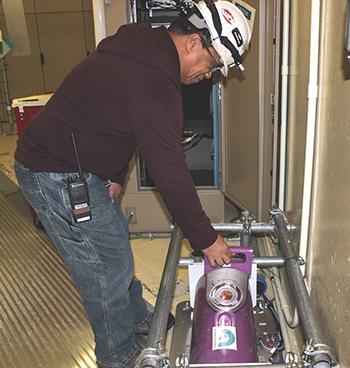Supplying the 'life-blood' of science
 (Download Image)
Nuclear Counting Facility staffers (from left) Todd Wooddy, Phil Torretto and Michaele Kashgarian place a NIF diagnostic sample in a sample changer for gamma-ray analysis. Photo by Julie Russell/LLNL
(Download Image)
Nuclear Counting Facility staffers (from left) Todd Wooddy, Phil Torretto and Michaele Kashgarian place a NIF diagnostic sample in a sample changer for gamma-ray analysis. Photo by Julie Russell/LLNL
Located one-and-a-half floors underground in LLNL's Bldg. 151, the Nuclear Counting Facility (NCF) leverages its well-shielded, low-background environment to accurately measure nuclear materials for the National ignition Facility (NIF) and a variety of other Laboratory programs.
The NCF has been providing high-sensitivity radiation measurements since the inception of radiochemical diagnostics in support of the U.S. Nuclear Test Program. Managed by Phil Torretto and staffed by Todd Wooddy, Pete Nunes and Michaele Kashgarian, the NCF provides critical data necessary for a diverse set of programs at the Laboratory so that they can carry out their scientific and programmatic missions.
"I like to think of data as the ‘life-blood’ of science," Torretto said. "And I think what gives me the most pride is that the NCF plays an integral role in providing that life-blood to the scientists here at LLNL."
The NCF supports applications in basic nuclear science, stockpile stewardship, nuclear safeguards and nonproliferation, nuclear forensics and counterterrorism, consequence management, emergency response and environmental monitoring.
NIF, one of the NCF’s largest customers, sends post-shot samples from several diagnostics—the Radiochemical Analysis of Gaseous Samples (RAGS) system, the Neutron Activation Diagnostic (NAD), and the Solid Radiochemical Collection Diagnostic (SRC)—to the NCF for counting.
The RAGS diagnostic is a cryogenic system designed to collect the gaseous debris from the NIF target chamber after a laser shot, then concentrate, purify and analyze the debris for radioactive gas products. Radiation detectors on the RAGS apparatus produce rapid, real-time measurements of the radioactivity content of the gas. Based on the results of the counting, the total number of radioactive atoms that were produced via nuclear reactions during a NIF shot can be determined. After the gas is collected, a sample is brought over to the NCF for additional counting to determine collection efficiency and number of atoms produced.
"Our group uses the NCF primarily for analysis of solid and gaseous debris samples collected following (NIF) shots," said radiochemist and RAGS principal investigator Dawn Shaughnessy. "Debris is collected and then counted in order to determine parameters such as fuel areal density, mix between interfaces, cross-sections, and fission yields."
The NAD measures the integrated neutron yield of a target capsule by activating a sample material, removing it from the target chamber, and determining the activation level using nuclear counting techniques. Specialized gamma-counting capabilities are required to analyze the material, making the NCF’s unique, highly calibrated gamma-counting systems the perfect fit.
"They measure the activity induced in the sample by NIF neutrons to within 3 percent, which allows other neutron diagnostics to be calibrated against this value on every shot," said Charles Yeamans, the scientist responsible for NIF neutron activation diagnostics.
During a NIF shot, bulk target materials, as well as trace elements in targets, can be activated by neutrons or possibly even charged particles to produce radioactive species. SRC collection plates are placed 50 centimeters from the target to collect the solid debris created by the implosion, which may contain some of these radioactive species. The SRC plates are removed post-shot, and the presence of radioactive isotopes is determined by the NCF.
While these diagnostics send a prolific amount of samples to the NCF for gamma-ray analysis, the facility also supports work in a variety of other important areas.
"The Nuclear Counting Facility is the workhorse for analyzing radioactive samples that are generated for a variety of projects," Shaughnessy said. "We also rely on the NCF for nuclear forensic samples, either real interdicted materials that are analyzed, or production and evaluation of synthetic debris used to exercise the nuclear forensics community. We send many samples there per month and rely on the extremely well-characterized detectors to provide us high-quality data that is used for a wide variety of mission support."
Torretto added that through LLNL’s Consequence Management program, the NCF played a crucial role in the Department of Energy’s response to the reactor accident at Fukushima in April-May 2011.
"In a six-week period, NCF was called upon to perform detailed gamma-ray analyses on more than 700 samples collected from areas affected by the Fukushima disaster in Japan," he said.
Contact
 Breanna Bishop
Breanna Bishop
[email protected]
(925) 423-9802
Related Links
Providing data for nuclear detectivesNational Ignition Facility
Tags
Nuclear deterrenceStockpile stewardship
Lasers and Optical S&T
Lasers
National Ignition Facility and Photon Science
Featured Articles








